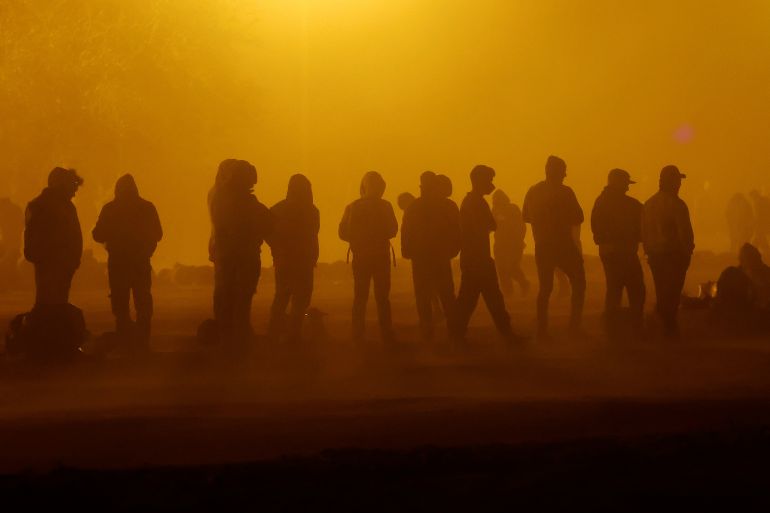Dying without borders
Death follows the journeys of people desperate to reach safety across militarised borders.

On November 6 in the city of Tapachula in Mexico’s Chiapas state, just down the road from the border with Guatemala, a young woman lay face down on the pavement in front of one of the offices of COMAR, the Mexican Commission for Refugee Assistance. Generally speaking, “refugee assistance” means stymying the northward movement of desperate refugees at the behest of the United States.
I happened to be passing by the COMAR office on my way to the municipal cemetery of Tapachula, where earlier in the year I had visited a mass grave containing the unidentified remains of refugees who had perished in the city. As the policeman stationed in front of the office was busy staring into space, I stopped to ask bystanders what had befallen the prostrate woman.
“She suffers from high blood pressure,” was the response from Yessica, a Honduran woman holding a visibly ill infant in her arms as four other children ran in circles around her. Yessica had arrived in Tapachula 10 days earlier after travelling with her kids from the Honduran town of Tela through Guatemala, where, she said, they had been robbed of everything they had. They were now sleeping on the street trying to figure out how to proceed north in the face of “refugee assistance”.
In explaining why she had fled Honduras, Yessica cited a motive commonly invoked by refugees from the country: its spectacular levels of violence, which became even more so following the 2009 US-backed coup d’état when homicides and femicides surged. Yessica had another uniquely dreadful reason for needing to get to the US, however, which was that her son was buried there.
The son had been living with his father in Kansas City, Missouri, where he had died, apparently by drowning, in 2022, at the age of 13. If she could not cry at the grave of her son, Yessica told me, she would never be able to come to grips with his death and move forward. As she spoke to me, two of her daughters inspected my bracelets, and the infant in her arms sucked on the barrel of a small grey plastic gun.
The prostrate woman didn’t budge, but Yessica had committed to keeping an eye on her for the time being.
In addition to helping make Honduras a difficult place to stay alive in, the US was now forcing Yessica to risk her own life and those of her remaining children as she navigated a militarised border regime – all in the hopes of properly grieving her son and moving on with life.
As if death weren’t bad enough already, borders can just make it all worse.
Shortly before I left for Tapachula from my pseudo-base in the village of Zipolite in the neighbouring state of Oaxaca, the son of a humble electrician in the village died in California at the age of 36. The repatriation of the body was a lengthy bureaucratic nightmare that came with a price tag of $11,000, the father told me – i.e. more money than some Mexicans earn in three years. When the body finally arrived, traditional candles were prohibited at the wake due to the family’s concern about the effects of added heat on a long-dead corpse.
Then, of course, there are the countless folks who die trying to cross borders. The Sonoran Desert on the US-Mexico border has become a graveyard for desperate refugees and migrants as has the hostile stretch of jungle known as the Darién Gap between Colombia and Panama – itself a veritable extension of the US border.
In Tapachula, I spoke with a 10-member Venezuelan family who had recently traversed the Darien Gap and reported seeing bodies, including of children and pregnant women. One of the family members commented matter-of-factly: “I can say that we have all stepped on dead people.”
Farther afield, the Mediterranean Sea serves as a maritime graveyard for refugees trying to reach a continent whose citizens are largely free to cross borders as they please. As of September, more than 2,500 people had already died or gone missing this year while pursuing the Mediterranean route to Europe.
But there is no limit to the ways borders not only cause but also complicate the most human phenomenon of death. When my Lebanese-Palestinian friend’s grandmother, a native of the Gaza Strip, passed away a few years ago in Jordan, the family naturally wanted her buried at home in Gaza. According to the state of Israel, my friend said, such an undertaking would have required an Israeli-performed autopsy to determine whether a dead 90-year-old Palestinian constituted a security threat. The family abandoned the plan.
Meanwhile, back in Tapachula, the mass grave of unidentified bodies remains untouched in the far back corner of the municipal cemetery. When I revisited the cemetery after my encounter with Yessica, the graveyard keepers informed me that no new remains had been added to the mass grave – which does not mean that refugees are no longer dying unidentified in Tapachula but rather that they are being interred elsewhere in the city.
It is unlikely that the family members of those buried in this desolate patch of earth near the Mexican-Guatemalan border will ever know the fates of their loved ones. Yessica, on the other hand, is determined to attain cross-border closure – or to die trying.
The views expressed in this article are the author’s own and do not necessarily reflect Al Jazeera’s editorial stance.
